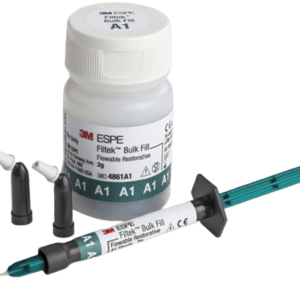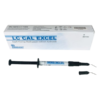Ammdent Lc Cal Excel Light-curing radiopaque calcium hydroxide
FEATURES
- High Resistance.
- Excellent adhesion.
- High Compressive Strength.
- Very Stable.
- Excellent Biocompatibil.
Read More
DESCRIPTION
Ammdent Lc Cal Excel is a light-curing radiopaque one-component calcium hydroxide material for cavity lining (base )for direct/Indirect pulp capping especially under Composites.
To prevent marginal leakage and infiltration of bacteria in the cervical/approximal margins, permanent isolation is recommended.
LC CALEXCEL can be directly applied to the tube. In the case of linings of more than 1mm apply and polymerize layer.
INDICATION :
- As a liner for indirect pulp capping.
- As liner under all filling materials.
- As protection against acid when applying the total-etch technique.
ADVANTAGES :
- Time-saving, direct application, and light-curing.
- Ready to use one component material.
- Acid Resistant.
- Effective protection of the pulp.
- It helps in the formation of secondary dentine.
- Excellent adhesion to composites.
- Low solubility in oral fluids.
- Syringe type for easy delivery of the paste into the canal.
- 2 Extra Tips for prevention of cross contamination.
- Excellent antibacterial effect and radio-opacity.
- Premixed Paste.
KEY SPECIFICATION
CAUTION :
- Store in a cool place and the cap always closed to prevent drying and phase separation of the material.
PACKING
DIRECTION TO USE
APPLICATION :
- The dental surfaces have to be dried thoroughly and contamination has to be avoided.
- The preparation corresponds to the rules of the usual filling technique.
- In direct proximity of the pulp, the application of an aqueous calcium hydroxide preparation is recommended. (CAL-EXCEL).
STEP 1:
- Cure LC CAL EXCEL with halogen light.
STEP 2:
- keep the light source as close as possible to the surface(approx1-2mm)and cure for at least 40-60 s.
STEP 3:
- In case of more distance extend curing time.
STEP 4:
- Carefully remove excess materials with a rotating instrument and apply the filling according to the manufacturer’s instructions.
STEP 5:
- LC CALEXCEL adheres to materials,e.g.crown and bridge materials, temporary sealants on methacrylate basis, certain impression materials (e.g.polyether).
STEP 6:
- This could lead to the removal of the lining (core build-up).
STEP 7:
- In such cases, it isrecommended to apply an isolating agent(e.g.vasline, glycerine gel or similar).
STEP 8:
- Remove isolating agent prior to definite application.
STEP 9 :
- The consistency of LC CALEXCEL does not allow to remove excess material with a probe, this could eventually remove the whole linning (use a rotating instrument).
STEP 10:
- After the use of LCEXCEL avoid direct light (operation lamp, sunlight)and apply the material immediately.
STEP 11:
- LC CALEXCEL contains calcium hydroxide, TEGDMA, BHT, UDMA, and amine. Do not apply the material in the case of patients with known allergies against the ingredients.
STEP 12:
- Eugenol and other contaminations (e.g.thymol)prevent the polymerization, therefore avoid contact with these materials.
STEP 13:
- Too short curing times and sufficient light intensity lead to incomplete curing, therefore check the halogen lamp/light guide regularly.
STEP 14:
- Eugenol and other contaminations (e.g.thymol)prevent the polymerization, therefore avoid contact with these materials.
STEP 15:
- Too short curing times and sufficient light intensity lead to incomplete curing, therefore check the halogen lamp/light guide regularly.
Categories: Obturation material, Resin cements, Restorative Tag: Light-curing radiopaque calcium hydroxide








Reviews
There are no reviews yet.